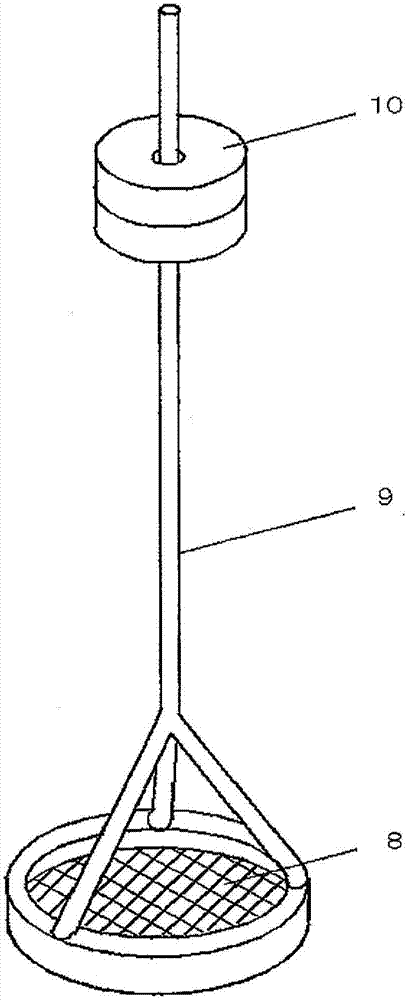Process for producing aqueous-liquid-absorbing resin particles, aqueous-liquid-absorbing resin particles, absorbent, and absorbent article
A technology of resin particles and a manufacturing method, which is applied in the fields of the manufacture of water-based liquid-absorbent resin particles, water-based liquid-absorbent resin particles, absorbers and absorbent articles, can solve the problem that the resin particles damage the liquid permeability, reduce and reduce the absorption capacity. and other problems, to achieve the effect of excellent liquid permeability, excellent absorption performance, and stable absorption performance
- Summary
- Abstract
- Description
- Claims
- Application Information
AI Technical Summary
Problems solved by technology
Method used
Image
Examples
Embodiment 1
[0142] Acrylic acid (a1-1) {Mitsubishi Chemical Co., Ltd., purity 100%} 131 parts, crosslinking agent (b-1) {pentaerythritol triallyl ether, Daiso Co., Ltd.} 0.44 parts, and deionized water 362 parts Stir, mix, and store at 3°C. Nitrogen gas is blown into the mixture so that the amount of dissolved oxygen is less than 1ppm, and then 0.5 part of 1% aqueous hydrogen peroxide solution, 1 part of 2% ascorbic acid aqueous solution and 2% of 2,2'-azobiamidinopropane di-salt are added 0.1 part of aqueous salt solution and mixed to start polymerization. After the temperature of the mixture reached 80°C, it was polymerized at 80±2°C for about 5 hours, thereby obtaining a hydrogel.
[0143] Next, this aqueous gel was minced with a mincer (12VR-400K manufactured by ROYAL Co., Ltd.), and 162 parts of a 45% sodium hydroxide aqueous solution was added and mixed and neutralized to obtain a neutralized gel. The neutralized hydrogel was further dried using a ventilated dryer {200°C, wind spe...
Embodiment 2
[0146] While stirring 100 parts of the resin particles (B-1) obtained in the same manner as in Example 1 at a high speed (a high-speed paddle mixer manufactured by Hosokawa Micron: a rotation speed of 2000 rpm), simultaneously add therein the resin particles having 4 or less carbon atoms. A mixture of 0.6 parts of propylene glycol of the polyhydric alcohol (c), 0.09 parts of ethylene glycol diglycidyl ether and 1.1 parts of water as the polyglycidyl compound (e), and a polyhydric alcohol having 4 or less carbon atoms ( c) 0.5 parts of propylene glycol, 1.2 parts of sodium aluminum sulfate dodecahydrate as polyvalent metal salt (d), and 2.3 parts of water are mixed and uniformly mixed, and then heated at 130° C. for 30 minutes to obtain the present Inventive aqueous liquid-absorbent resin particles (P-2).
Embodiment 3
[0148] While stirring 100 parts of the resin particles (B-1) obtained in the same manner as in Example 1 at a high speed (a high-speed paddle mixer manufactured by Hosokawa Micron: a rotation speed of 2000 rpm), simultaneously add the resin particles having 4 or less carbon atoms. 0.6 parts of propylene glycol as the polyhydric alcohol (c), 0.09 parts of ethylene glycol diglycidyl ether as the polyglycidyl compound (e), Klebosol30cal25 (colloidal dioxide produced by AZ Material Co., Ltd.) as the inorganic particle (f) A mixture of 1 part of silicon) and 1.1 parts of water, 0.5 parts of propylene glycol as a polyol (c) having 4 or less carbon atoms, and sodium aluminum sulfate dodecahydrate as a polyvalent metal salt (d) 1.2 parts and 2.3 parts of water were mixed and uniformly mixed, and then heated at 130° C. for 30 minutes to obtain aqueous liquid-absorbent resin particles (P-3) of the present invention.
PUM
| Property | Measurement | Unit |
|---|---|---|
| size | aaaaa | aaaaa |
| diameter | aaaaa | aaaaa |
Abstract
Description
Claims
Application Information
 Login to View More
Login to View More - R&D
- Intellectual Property
- Life Sciences
- Materials
- Tech Scout
- Unparalleled Data Quality
- Higher Quality Content
- 60% Fewer Hallucinations
Browse by: Latest US Patents, China's latest patents, Technical Efficacy Thesaurus, Application Domain, Technology Topic, Popular Technical Reports.
© 2025 PatSnap. All rights reserved.Legal|Privacy policy|Modern Slavery Act Transparency Statement|Sitemap|About US| Contact US: help@patsnap.com



